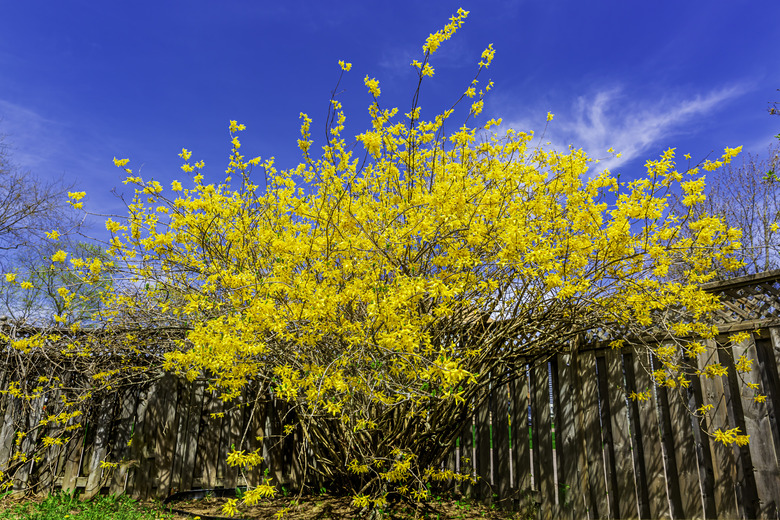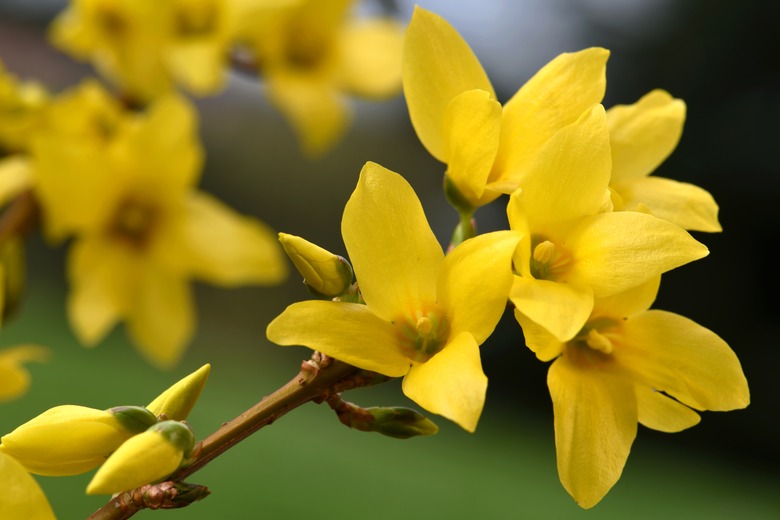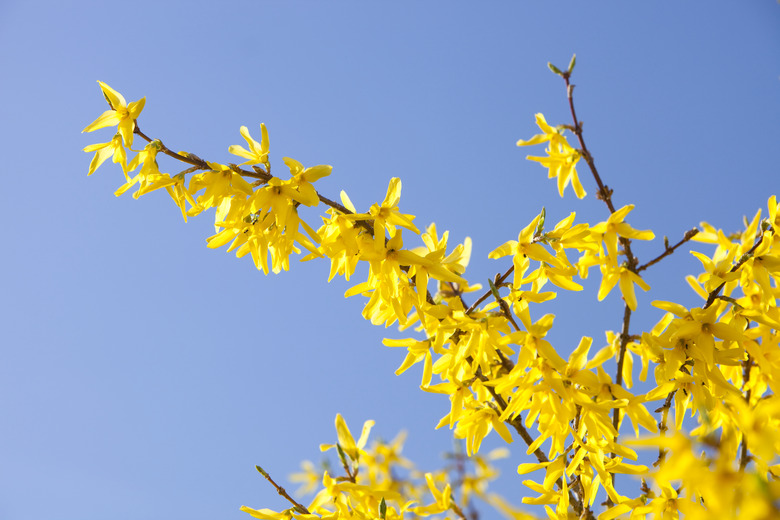How To Grow Forsythia
We may receive a commission on purchases made from links.
- Best uses for forsythia
- How to grow forsythia
- In what zone does forsythia grow best?
- When should you plant forsythia?
- Soil, sunlight and water recommendations for forsythia
- How to propagate forsythia
- How to harvest forsythia
- Common pests and other problems for forsythia
- Common diseases for forsythia
If you're the kind of gardener who starts itching for spring as soon as the groundhog pops his head out of his burrow in February, a forsythia (Forsythia spp.) might be for you. These beautiful and fragrant shrubs burst into bright-yellow blossoms early in the spring, sprouting bright yellow flowers before they do leaves. Blooms may appear as early as February, depending on where you live, promising that spring is right around the corner. When the flowers fade, they leave behind an attractive deep-green shrub that looks nice by itself or as a backdrop for summer-blooming plants.
Best Uses for Forsythia
Best Uses for Forsythia
A plant of substance, forsythia brings more to the table than just good looks. A standard forsythia plant reaches 8 to 10 feet in height and does so quickly, growing around 24 inches a year. They also spread as far as 12 feet, making them an excellent natural hedge. Forsythias also fill in sunny slopes, making them a good substitute for lawn grass on steep hills.
Forsythia bushes also make nice border plants, but it's best to avoid planting them next to walkways and driveways. Because these plants grow rapidly, you may find them constantly muscling their way into your sidewalk space and narrowing the traffic path. Choose a planting location where you can appreciate their long, sweeping branches rather than fighting to keep them trimmed back.
Some types of forsythia also work well as a ground cover. These cultivars, like Gold Tide forsythia (Forsythia 'Courtasol,' USDA zones 5-8) and greenstem forsythia (Forsythia viridissima 'Bronxensis,' zones 6-8) only grow 1 to 2 feet tall and are sometimes used as foundation plantings.
Be careful when planting forsythia for fall color. The plants are deciduous, and their leaves do change colors in the fall. Some individuals do so spectacularly with their leaves turning to a beautifully deep shade of purple. Other individuals put on far more mundane displays, however, and may disappoint. To improve your chances of vibrant fall color, plant your forsythia in full sun.
Nature lovers can count on forsythia to attract butterflies, birds and bees. The birds and butterflies are fun to watch, and the bees will help pollinate other flowers in your garden.
How to Grow Forsythia
How to Grow Forsythia
- Common Name: Forsythia
- Botanical Name: Forsythia spp.
- When to Plant: In the fall when the plant is dormant
- USDA Zones: 4-8, depending on species and cultivar
- Sun Exposure: Full sun
- Soil Type: Moist, well-draining soil
- When it's in Trouble: Discolored, wilting leaves; lower branches die off
- When it's Thriving: Colorful spring blooms, deep-green summer leaves, rapid growth
Starting Forsythia From a Seedling
The fastest and easiest way to enjoy a forsythia plant is to start with a young shrub from the nursery. Planting is easy and requires no special techniques. Simply dig a planting hole twice as wide as your forsythia's root ball and equally deep.
Set the forsythia in the ground so that the top of the root ball sits at the top of the planting hole. Backfill the hole with native soil and water the new plant deeply. There is no need to fertilize your shrub at this time, as you should let the plant focus on settling in rather than growing.
Space standard forsythia plants at least 6 feet apart. You can plant dwarf varieties with as little as 2 to 3 feet of space between them. Disease issues are rare in forsythias, so spacing and air circulation aren't as crucial for these plants as they are for many others.
In What Zone Does Forsythia Grow Best?
In What Zone Does Forsythia Grow Best?
Forsythia grows best in U.S. Department of Agriculture plant hardiness zones 5 through 8. However, this does not mean that any forsythia can grow anywhere. As always, when choosing plants, you'll need to choose one that can handle the winters in your area.
Forsythia x intermedia 'Lynwood,' for example, is hardy only in USDA zones 6 and warmer. Gardeners in zone 4 will do better with Forsythia 'Northern Sun.' If you're not sure which forsythia will work for you, call your local cooperative extension service. You can also visit your local garden center, which likely carries only plants that will grow in your area.
When Should You Plant Forsythia?
When Should You Plant Forsythia?
Ideally, you should plant forsythia in the fall when it goes dormant. Some gardeners prefer a spring planting, however, and this is equally acceptable as long as the danger of frost has passed. Forsythias are very relaxed plants. As long as you avoid planting during possible frost times and during the height of summer heat, your plant will do just fine.
Soil, Sunlight and Water Recommendations for Forsythia
Soil, Sunlight and Water Recommendations for Forsythia
When planting a forsythia, choose a bright spot in full sun. The plant will tolerate part shade but won't produce nearly as many of its bell-shaped flowers as it will in the sun. Forsythias planted in partial shade are also more likely to produce dull fall foliage.
Luckily, forsythias aren't particular about their soil and will grow just about anywhere. They prefer moist soil with a pH between 5.0 and 8.0, but they're highly adaptable. As long as you don't plant them where their feet will sit in water, you can expect lush growth and plentiful flowers from your bushes.
These plants are also quite drought tolerant once established and don't typically need irrigation. Try to keep the soil around them evenly moist for their first year. After that, these shallow-rooted plants should have no trouble soaking up the water they need even when rainfall is light.
You can begin to fertilize your forsythia if desired during its second growing season. Apply a balanced fertilizer early in the spring. A single application of a granular product will keep your forsythia happy for the entire growing season.
Due to their robust growth, forsythia plants often need pruning to keep them looking their best. Forsythia blooms on old wood, however, so improperly timed pruning can mean you won't get blooms next year. To avoid this, prune your shrub in the spring just after it flowers.
Remove obviously old and dead limbs at the ground along with any damaged or diseased ones. Next, move on to pruning away any branches as needed to reshape the plant. Avoid cutting thin, flexible new growth, as this will flower next year. It's generally safe to cut away thick, woody branches.
If you've neglected your forsythia's pruning for a few seasons and the plant has become ungainly, cut back the entire plant so it is only 3 or 4 inches high. The plant will grow back and give you another chance to stay on top of your pruning and keep its growth under control.
How to Propagate Forsythia
How to Propagate Forsythia
If you fall in love with your new forsythia at first bloom, you'll be happy to know that these plants are easy to propagate from cuttings. You can have as many as you want without having to buy more plants at the nursery.
To make more forsythias, take 6-inch cuttings from your plant. Choose limbs that are strong yet flexible and healthy. The best time to do this is early to mid-summer. Remove the leaves from the bottom two-thirds of the cutting and plant them in potting soil. Place the planted cuttings in a shaded area where the temperature is around 68 degrees Fahrenheit and keep their soil moist. They'll root quickly and easily for transplanting later in the season or early the following spring.
If desired, you can also propagate forsythia through layering. To do so, choose a healthy branch at the bottom of your forsythia plant in the spring. Shave away the bark on the limb somewhere near the middle or end of the branch to create a bare spot.
Place a container full of potting soil next to the branch and lay the branch in it so that the bare spot you made is against the soil. Stake down the limb so it stays in place and then wait. The limb will start to form roots in the pot and create a new forsythia plant. When it's big enough to take care of itself, simply cut the new forsythia off the old plant with pruning shears.
How to Harvest Forsythia
How to Harvest Forsythia
Many gardeners enjoy bringing forsythia blooms inside for a pop of color and fragrance. Happily, you don't need to wait until the shrub blooms to do so. You can just cut a few stems from your forsythia plant late in the winter or early in the spring and set them in a vase of water inside. The stems will bloom in about a week, allowing you to enjoy your flowers indoors even before they flower outdoors.
Common Pests and Other Problems for Forsythia
Common Pests and Other Problems for Forsythia
Forsythia plants rarely have pest or disease problems, and most gardeners enjoy them without issues. Like all plants, however, the tender young leaves of the forsythia plant may attract aphids and scale insect visitors looking for a juicy meal. You can shoot these pests off your plant with a hose or treat them with insecticidal soap if they bother you.
Sometimes, the four-lined plant bug visits forsythia bushes. About 1/3 inch long, these winged yellow-green bugs mature in June and feature four black stripes along their backs. After dining on forsythia leaves, they leave behind a depressed area around puncture wounds. Like aphids and scale, you can treat the four-lined plant bug with insecticidal soap.
Two-banded Japanese weevils may also visit your forsythia bushes. These insects eat the edges of the plant's leaves. They're about 1/4-inch long and are a mottled brown and gray color. If you see these insects on your plants, treat them with acephate.
Common Diseases for Forsythia
Common Diseases for Forsythia
Although susceptible to root rot if not given proper drainage, forsythia plants rarely suffer from disease. It is possible, however, for forsythias to suffer from galls. Galls are knobby growths that form on the plant's branches, and their cause is unknown. Unfortunately, the only treatment is to prune out affected limbs. If you do, make sure you sanitize your pruning shears with alcohol between cuts so you don't inadvertently spread the disease.
Twig blight can also affect forsythias. In this disease, the bottom limbs of the forsythia will start to die. If you split open these stems, you'll find black spots or nodules inside. To treat twig blight, remove the affected limbs and treat the plant with a fungicide.


